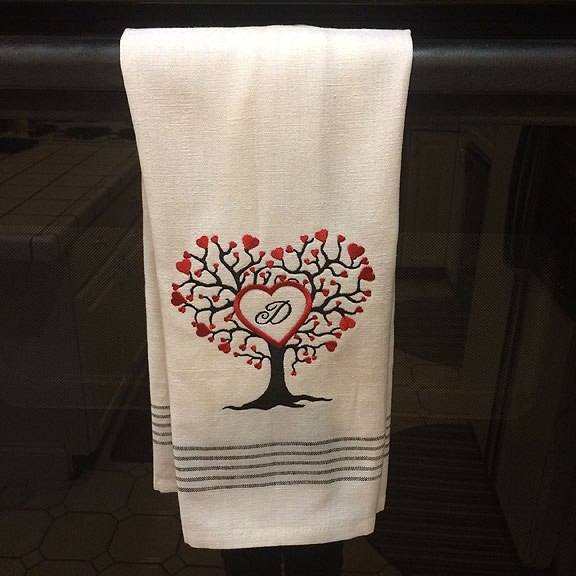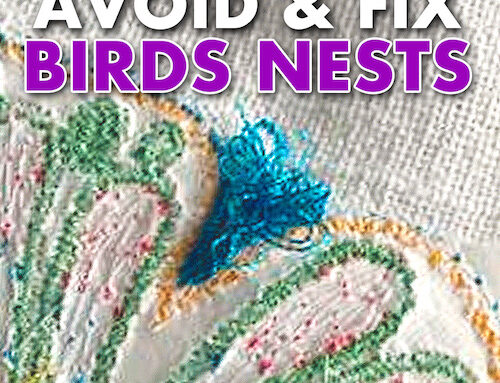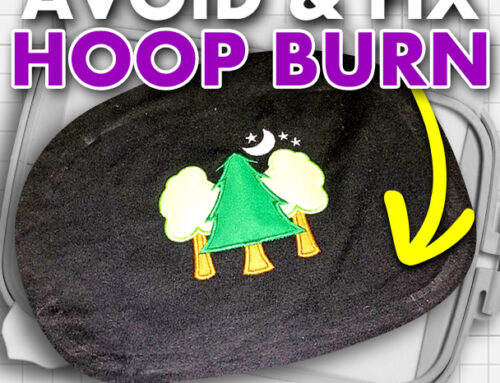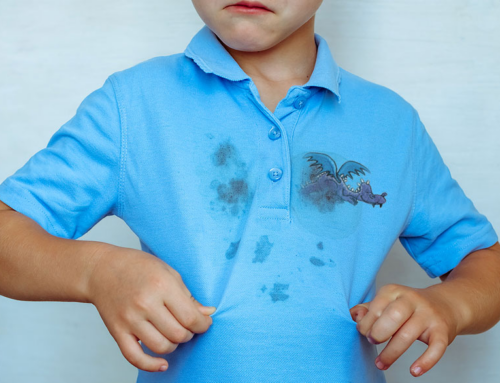When I finally got brave enough to take my embroidery machine out of the box, the first item I embroidered was a towel. I figured, how hard could it be? Well… it wasn’t quite as easy as I thought, and I managed to make plenty of mistakes.
But, it’s been about 10 years since that first attempt, and since then, I’ve learned from all my mishaps. At this point, I could probably monogram a towel in my sleep. Having done this for so long, I now know what I need to do to achieve the best results.
Click the image above to view the design. It is also included in the Embroidery Legacy Design Club. Click here to learn more about the club.
Although there are a few tactics to keep in mind, embroidering a name, monogram, or a design on a terry cloth towel is still an appropriate project for a beginner. The terry cloth material is fairly easy to work with because it doesn’t stretch and tear. Plus, towels are flat, so they are easy to embroider without excess fabric getting in the way. And, finally, towels (especially dish towels) are pretty inexpensive. So, if you screw one up, you’re not out too much.
Once you master embroidering on terry cloth materials, there are loads of projects you can tackle beyond adding a simple name or monogram on a towel. And, they all make fantastic gifts for a variety of recipients on many different occasions.
Personalizing All Types Of Terry Cloth Items
Monogrammed Bath Towels Are A Great Wedding Shower Gift
A monogrammed bath towel set is an inexpensive and thoughtful gift for a newly engaged or married couple. What better way to celebrate their combined home and shared initial? You can even purchase the towels off their registry and add a monogram. What couple wouldn’t like that gift? Looking back on the towel collection my husband and I owned when we were first married, a monogrammed set of bath towels would have been a huge upgrade.
If you decide to monogram a set of towels for a couple, you can either do a traditional monogram or a more modern-looking single initial. If you choose a traditional monogram, it is customary to place the last name initial in the center, the woman’s first name initial on the left, and the man’s initial on the right.

If, on the other hand, you choose a single initial monogram, there are a lot of options. I really like the look of a single initial flanked with a decorative border.
For both these styles of monograms, several typefaces that come preloaded with Hatch embroidery software are suitable. Plus, using them is as easy as typing the monogram out on your keyboard.
You can now learn how to create your own personalized monogrammed towel in our new free premium lesson with our very own, Linda Rayburn! Did I mention we’ll even throw in a free ESA monogram for the lesson (a $9.95 value!), click here to access your free personalized monogrammed towel Hatch project. Don’t have Hatch yet? No problem, Click here to download a free 30 day trial of Hatch through us and learn more now. Hatch’s ESA font technology makes embroidery lettering & monogramming easier than ever before.

More of a visual learner? Join us in our How to Embroider on Terry Cloth Towels YouTube video where we take you step by step to create your own personalized monogram onto your towel while using Hatch smash. Hatch smash ensures your design lays flat on the groves of the terry cloth. Did we mention we throw in an extra ESA font so you can personalize your own monogram? Click here to watch and find out more.
Personalized Luxurious Terry Cloth Robes
Another great gift for a bride and groom is personalizing a coordinating set of monogrammed robes. Once you master embroidering on a terry cloth towel, a terry cloth robe is really no different. And, if they are a newly engaged or married couple, it’s unlikely that they have matching robes yet.
Hooded Bath Towels Are The Perfect Baby Gift
Another type of towel that you can personalize with your embroidery machine is a hooded bath towel – the perfect baby gift! Hooded towels make it so easy to bundle up the baby when getting out of the bath. When our kids were babies, I think hooded towels were the only ones we used on them.
There are tons of fun appliqué designs that can be stitched on the front of the hood, like monster faces and other characters, but a simple monogram or name is also a great option to embellish a hooded towel.
Beach Towels Are Great Kid Gifts
If the kids you’re stitching for are too old for hooded baby towels, consider personalizing a beach towel on your embroidery machine. Beach towels are useful throughout the year for hot tubbing, indoor swimming, and swim team practice. Plus, when the kid inevitably leaves their towel at a friend’s house or a public pool, they will more likely get it back if their name is stitched on it.
You can usually find high-quality beach towels at places like Costco or Sam’s Club. But, the availability (at least in the Midwest) is seasonal, so you need to stock up in the summertime to be able to give personalized beach towels year-round.
Click the image above to view this cute design. It is also included in the Embroidery Legacy Design Club. Click here to learn more about the club.
Hand Towels Are Great For A Hostess Gift
If you’re looking for a fun and easy personalized host/hostess gift as you hit the holiday party circuit, pick up some hand or dish towels at your local Marshalls or TJ Maxx and stitch out a festive design with the family’s name.
There are some pretty elegant, hilarious, and festive designs that you can purchase and then personalize by adding the last name of the house onto the bottom.
Click the image above to view the design. It is also included in the Embroidery Legacy Design Club. Click here to learn more about the club.
Challenges Of Embroidering On Terry Cloth Towels & Textiles
Now that I’ve convinced you that terry cloth items make great gifts for just about anyone, you may be wondering what you should know before embroidering on this type of material. The primary challenge you will encounter is proper placement of the embroidery design on the towel (or robe) and getting the embroidery design to cover this highly textured fabric. Terry cloth material has a significant nap, and the fibers of the fabric will want to poke through the stitches of your embroidery design.
For this reason, successful embroidery on towels begins with choosing an appropriate embroidery design. If you are stitching letters (such as a monogram) on a towel, choose a typeface with strokes that are not too thin. Very thin letters will get lost in the surrounding nap of the terry cloth fabric. For best results, once again, use Hatch’s industry-leading ESA font technology.
If you are stitching out a decorative design, a well-digitized design that includes a crucial layer of stitching called a “Hatch Smash” stitch (which helps tack down the fabric fibers before the final layer of stitching) will yield the best results. Designs digitized with this extra layer of underlay look more polished once they are stitched out (more on this from John Deer below).

This wreath embroidery design from Embroidery Legacy has been digitized thoughtfully. The traveling stitches between the berries are covered by the leaf stitching, which means no jump stitches to trim. Also, the underlay stitching underneath the leaves ensures thorough coverage.
Not All Embroidery Designs Are Digitized for Towels & How to Fix Them
A note from John Deer (owner of Embroidery Legacy):
As Julie mentioned, embroidering on towels is kind of like the Bermuda triangle of embroidery… When designs are sewn onto towels, often times the thread can sink in and become lost in the fabric due to the towel’s high pile.
To fix this, a fill stitch called a “Hatch Smash” or sometimes “knockdown” stitch can be added to finished designs that have already been digitized. The Hatch Smash adds a loose-fill stitch with no underlay and no traveling stitches underneath the finished design to hold down the terry cloth. This creates a solid foundation of underlay on the towel that the design can be embroidered on top of, instead of being embroidered directly onto towel where the stitches will sink in.
Here’s a quick video showing you how to easily add in a Hatch Smash stitch to designs you plan to embroider on towels:
Side note: If you want to stay up to date with new embroidery project ideas, tutorials, tips, and tricks, be sure to subscribe to our YouTube channel by clicking the button above.
If you’d like to try the Hatch Smash technique yourself, you can download a free 30-day trial of Hatch through Embroidery Legacy by clicking here. We’ll also send you some bonus lessons to help get familiar with the software quickly.
Also, considering this blog is about embroidering on towels, not digitizing on towels, I’ll spare you from some more in-depth details about digitizing on towels. However, if you want more details, click here to check out the article I wrote called Embroidery Digitizing for Towels. Anyways, back to Julie’s wonderful article!
Choosing The Appropriate-Sized Design
Ensure the embroidery design you select to stitch out on your towel is an appropriate size for the towel you are stitching on. A teeny tiny design on a large bath towel will get lost in a sea of terry cloth. And a design that is too large, for example, on a hand towel, will not be adequately displayed when folded in thirds and hung over a towel bar. Typically, a 4” x 4” design is an appropriate size for a hand towel.
The monograms that I embroider on large bath towels are typically about 4 inches tall by 4 inches wide. For the coordinating hand towel, I will stitch out a monogram about 3” x 3”.
How To Float A Towel For Embroidery
One method I’m a fan of is floating the towel instead of hooping it. Hooping a towel (or something made of terry cloth material) can be difficult for beginners because of the thickness of the material. Plus, forcing towels into the hoop can distort and stretch the knap of the fibers. Floating means that you hoop the stabilizer, then stick the towel to the hooped stabilizer.

Pictured above, I have hooped my adhesive backed stabilizer securely in the hoop.
Adhesive-backed tear away is my stabilizer of choice when embroidering on towels. I simply hoop it with the glossy side up and the hooping tight enough that I could bounce a quarter off of it. Then I score around the inside edge of the hoop with a pin to allow me to peel away the paper, exposing the sticky surface.
Regular tear away stabilizer also works well for embroidering on towels; you will just need to spray the hooped stabilizer with a temporary adhesive. It’s a good idea to make a simple cardboard mask to cover your embroidery hoop while you spray the tear away with temporary adhesive. It keeps your hoop from getting sticky.
Placing The Design On The Towel
Centering the design on the towel is simple once you have the tear away stabilizer hooped. On the hooped stabilizer, draw a line marking the center line both horizontally and vertically. If you are using regular tear away and spray adhesive, draw the lines before spraying the adhesive. However, if you use adhesive-backed tear away, draw the lines on the tear away after exposing the sticky paper.

I always draw a crosshair at the center of the hoop on the hooped stabilizer.
Now you have to decide where you want to place the center of the embroidery design on the towel. I typically center a monogram on a large bath towel about 8 inches up from the bottom edge of the towel. For a hand towel, I would use a distance of about 5 inches from the bottom edge. You may need to adjust this distance if your towel has a decorative border. When this is the case, I make sure that the bottom edge of the design is at least 1” from the border so that the design or monogram has a bit of breathing room.
The next step is to line up the center point of the hooped stabilizer with the center point of your desired location of the embroidery design. To do this, I first mark the center point of the bottom edge of the towel and the center point of the design using a pin. Then I fold the towel along that vertical line with right sides together. Line up the pin by marking the center of the design with the center point of the stabilizer and aligning the fold of the towel with the vertical line drawn on the stabilizer. Once one half is stuck to the stabilizer, unfold the towel and smooth it out.

I mark the desired center point of the design on the towel with a pin.

Folding the towel in half and aligning it on the center line of the hooped stabilizer helps to center the design on the center of the towel.
Floating A Water-Soluble Topper On Top of The Towel
To ensure your stitching looks continuous, always float a piece of water-soluble topper over the towel before you start stitching. To help prevent this topper from bunching up while stitching, place the topper smooth side up.

A water-soluble topper prevents towel fibers from poking through the stitching
If you are working with towels with a very thick nap and are concerned about towel fibers poking through your stitching, you can also cover your towel with a piece of tulle. After you stitch out your design or monogram, simply tear the tulle away from the stitched area.
I usually use white bobbin thread when stitching out all my embroidery designs. However, if you want the back side of the towel to look more “finished,” you can match your bobbin thread to your top thread. Of course, the monogram will read backward on the back of the towel.
Cleaning Up Your Stitching For A More Polished Look
I made this personalized holiday hand towel using the wreath embroidery design from the Embroidery Legacy collection. Click the image above to view the design. It is also included in the Embroidery Legacy Design Club.
Once you finish stitching out your design or monogram, you can remove the towel from the hoop and clean it up. Trim all your jump stitches with a nipper. Peel away the water-soluble topper from the front side of your towel and as much tear away stabilizer as possible from the back side of your towel. Spritzing the front and the back of the towel with water and letting it soak in a bit will make your topper dissolve on the front and make the tear away come off the back of the towel more easily.
Try Embroidering on Towels for Yourself!
Congratulations! Now that you know how to embroider on a towel, the next step is to try it yourself! With our free Embroidery Legacy Design Kit, you can download the free Embroidery Legacy design shown above (plus 10 others). The Hatch Smash technique is already applied to ensure you get amazing embroidered results.
Thanks for reading, and if you enjoyed this article, don’t forget to comment below.
P.S. Don’t forget to take advantage of your free personalized monogrammed towel Hatch project, where you even get an ESA font for free! Monograms are a prestigious way to mark something as your own, why pay ridiculously high prices when you can do it yourself & learn how for free!











I’ve been doing lots of monogrammed towels recently. Currently all my thread is rayon, and I was advised at a recent digitising workshop that polyester thread would stand up better to the regular washing than the rayon. I note you advise rayon thread for terry towels, and wondered why. I was all set to start stocking up on poly thread, but I’m hesitant having read your article.
Hey Heather, we generally promote rayon while embroidering lace. I don’t believe this article mentioned using rayon for terry towels.
Rest assured, polyester will be just fine if you plan on monogramming towels 🙂 Thanks for commenting and happy stitching!
I must be going crackers! I was sure I’d read it in this article but reading it again (multiple times in fact) I can’t see it now. I’ve opted to stick with rayon and advise customers to avoid bleaching agents when washing, following a lengthy chat with my local fabric stockist.
Hi Heather, if you do use rayon just make sure that whatever embroidery design you’re running on your towels were digitized properly or you’ll run into multiple thread breaks. Also, yes I would stay away from bleaching agents. Happy stitching!
Thank you so much for the information. Sure makes the design stand out on the towel.
You’re most welcome! Agreed, the techniques above help avoid the stitches from sinking into the towel fibers.
I notice that you like using sticky stabilizer for towels. I love how easy it is, but every time I’ve tried it, I end up with stabilizer I can’t remove … or pulled pile if I try too hard. Is there a trick to getting it off cleanly?
Hi Lisa, if you have a Garment/Hand held steamer try applying some steam while removing.
Wonderful post! We are linking to this particularly great article on our site. Keep up the good writing.
Thanks Efrain, glad you enjoyed it 🙂
Good post. I learn something totally new and challenging on websites I stumbleupon on a daily basis. It’s always useful to read articles from other authors and practice a little something from their web sites.
Glad you enjoyed it Ardath! Happy stitching
bookmarked!!, I like your blog!
Thanks Waldo!
Thank you for doing these blog posts and the videos on YouTube. As one of many non-Facebook users I appreciate all learning possibilities that are made available for Hatch owners outside the Facebook platform.
Thank you for your support 🙂
Recently stitched out a rooster on some kitchen towels for a friend. Design was fairly dense so of course made the towel stiff. Is there a trick in how to make a design softer so the towel is actually usable? Or, is it just a given that most embroidered towels are for decoration only?
Hi Bernadette, depending on the designs, the format and the software you own property changes can be made to reduce the density within a design. It will depend on the designs and the experience of the user to make the proper changes. Low density designs would best be chosen for a towel to remain functional.
I wash my towels 2x to remove lint and preshrink..hot wash and dry….then I heavily starch the emb field and then dry it in dryer…spritz after and press….then 3 layers of Vilene for stabilizer, one at straight grain, one sideways grain and one at 45 degrees… float towel….then a sheet of vilene on top….use a knockdown stitch, then proceed….rewash towels when done…
Thanks for sharing Wendy 🙂